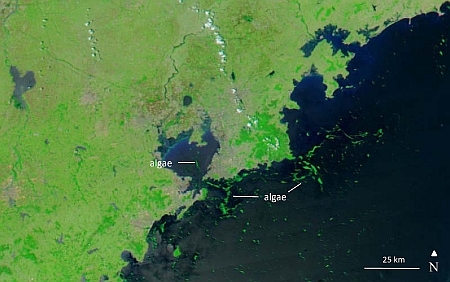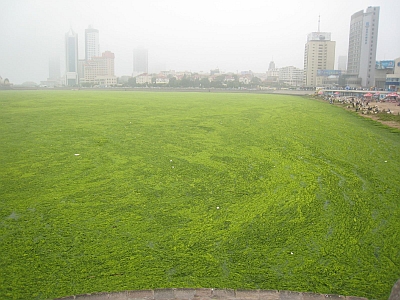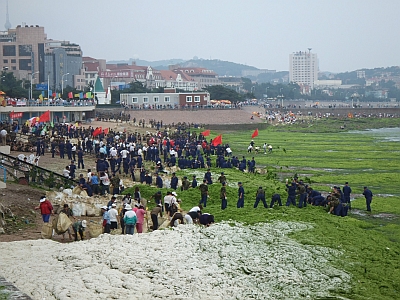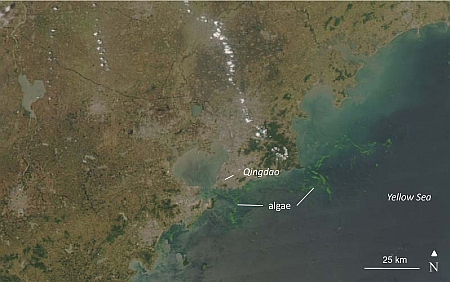3. Harmful Algal Blooms
Case Study: Algae invade olympic sailing venue

As Beijing prepared to host the 2008 Summer Olympics, the city of Qingdao, roughly 550 kilometers (340 miles) to the southeast, prepared its coastal waters for the games' sailing competitions. With the games looming just weeks away, Chinese officials and residents of Qingdao (also known as Tsingtao) struggled with a stubborn adversary: ALGAE all along the coast!
What happened?
According to news reports, opinions differed on the cause of the larger-than-normal algal bloom, with some people citing increased rainfall and unusually warm waters in the Yellow Sea. Others blamed wastewater, and industrial and agricultural pollution for providing excess nutrients on which the algae could thrive. Many coastal Chinese cities dump untreated sewage into the sea, and rivers and tributaries emptying into coastal waters are often contaminated with high levels of nitrates from agricultural and industrial runoff. These nitrates contribute to the algae that often bloom along sections of China's coastline.
The worst bloom ever
Regardless of the cause, many locals agreed that the algae bloom was the worst they had seen. In total, more than 13,000 square kilometres (5,000 square miles) of seawater were affected by the algal bloom.

The massive outbreak came with some sailing teams already in Qingdao preparing for the Olympics.
Solving the problem
With an international event such as the Olympic Games coming up, the whole world was paying careful attention to the problem and to the problem-solving strategies of the local Olympic Committee. With sailing events scheduled to begin on 9th August, Chinese officials ordered the algae cleanup to be completed by 15th July.
More than 1400 boats and 10,000 troops and volunteers were dispatched to help cleanup more than a million tonnes of algae from the coastal waters.
A local newspaper reported that on one weekend 11,000 college students had volunteered for cleanup duty over the weekend. Several companies had organised teams of employees to help.
In addition to removing algae from the coastal waters, local authorities set up barriers to keep the algae away from the sailing venue. One of the most important aspects of coping with the plague was however constant monitoring.
Watching the bloom from space
Growth and movement of the algal bloom were followed by a ship that sailed around the coastal waters off Qingdao.
The satellite images below show Qingdao and the Bay of Jiaozhou Wan at the beginning of the local cleanup effort. They were captured on 28th June 2008 by the Moderate Resolution Imaging Spectroradiometer (MODIS) on NASA's Aqua satellite.

Source: MODIS Rapid Response Project at NASA/GSFC
The top image is a true colour image similar to what a digital camera would photograph. The bottom image is a false colour image made from a combination of light visible to human eyes and infrared light our eyes cannot see. In this image, vegetation appears vibrant green, including the strips of algae floating in the bay and in the nearby coastal waters.
Daily images of the area have been made available from the MODIS Rapid Response Team.


